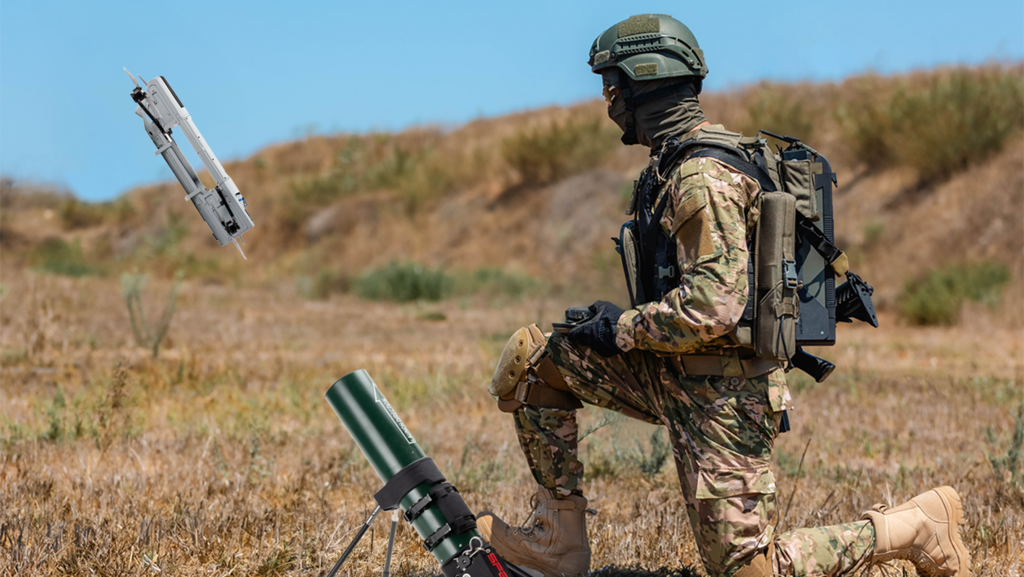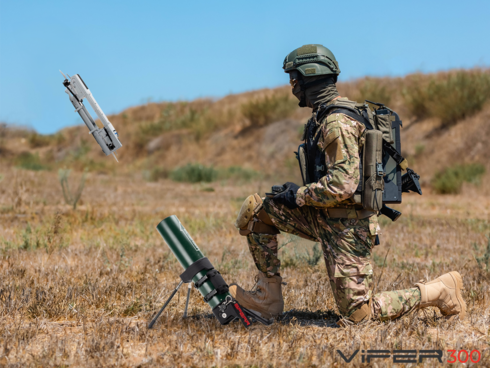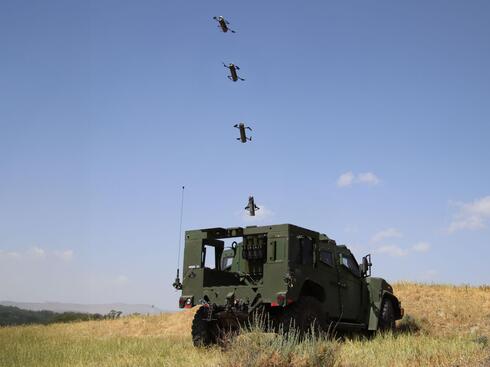
"An organic air force": Swarms, autonomy, and the future of drones
As part of CTech’s series on Israel’s unmanned aerialscape, Spear UAV's CEO explains how the Israeli company is pioneering encapsulated drones and pushing tactical UAVs into a new era as an airborne extension of the battalion.
“We are not a drone company. We are a system house for smart AI-based encapsulated launch loitering capability”, said Yiftach Kleinman, Spear UAV CEO, a company that produces unmanned aerial solutions designed for maneuvering forces. “This is the future. The future is not ‘drones,’” emphasized Kleinman, a reservist Colonel in the IDF and former Rafael executive.
In recent years, the drone industry has rapidly matured. Propelled by modern warfare, from the Russia-Ukraine war to Israel’s more recent war against Hamas and conflict with Iran, its capabilities have been cast into unprecedented focus. From defense powerhouses to specialized platforms, from AI-driven intelligence to counter-drone systems, the unmanned aerial landscape represents one of the most dynamic areas of defense technology.
In this series, CTech speaks with the companies driving Israel’s Unmanned Aerial Vehicles and Systems sector to map the industry, and the challenges and opportunities ahead.
While one might think they know what a drone is, not least when picturing it as a military-grade weapon, they may be surprised at how far the field has leapt from the days when devices built to film weddings were repurposed into makeshift weapons, with off-the-shelf quadcopters strapped with improvised explosives.
The evolution has also revealed the shortcomings of such rudimentary drones, often as much a threat to their handlers as to their intended targets. In their place, Original Equipment Manufacturers (OEMs) are stepping in with platforms designed for combat, including an influx from Israel’s own defense tech ecosystem: companies like Easy Aerial (autonomous ‘drone-in-a-box’ solutions), Steadicopter (advanced unmanned helicopters), and Sky Sapience (tethered systems).
Among them, Spear UAV (Spear), founded in 2017 by Gadi Kuperman, is moving the category with encapsulated machines that, more than drones, are weaponized systems intended to serve as “the organic air force of the battalion.”
Its flagship system, the VIPER, is an encapsulated UAV stored in sealed canisters and launched like a munition rather than assembled like a kit. It can be carried by infantry, mounted in multiples on vehicles, and launched from submarines. The latter capability marked progress in a field that had seen little change for decades, positioning Spear as one of the most prominent players in Israel’s dronescape.
The drone revolution: From weddings to weapons
Kleinman is adamant about drawing a clear line between his company’s product and the off-the-shelf quadcopters that are often lumped under the same umbrella term of “drone.”
Drones were originally “made to take videos of weddings,” he said. “They could bring your eye in the sky, but it's not a military grade solution.”
While Spear UAV represents a doctrinal shift in how drone technology is being applied on the battlefield: UAVs are no longer seen as niche add-ons, but increasingly as embedded and standardized elements of every combat unit.
In the past, and still today, militaries that improvise with cheap drones will often pay a steep price. “They just take a cheap drone, add some, let’s say, Soviet charge grenades,” Kleinman continued. “They have many, many self accidents with casualties because of these improvisations. We had such an accident here in Israel a few weeks ago.”
Even more sophisticated military systems still fall short on long-term viability. With most first-person view systems, Kleinman noted, “it takes about three months to train a good operator.”
He added that even now in markets like the US, with the Trump administration seeking to spur an overhaul of American defense manufacturing, there are still struggles with cost and practicality, producing drones that are “pretty expensive, not very stable, and big.”
By contrast, Spear’s encapsulated approach was built from the ground-up with the battlefield in mind. “It takes about two days to have a very good capability to operate the system,” Kleinman explained.
For Kleinman and his team, these design and functional distinctions make Spear more than a drone manufacturer, but something more fundamental and, he argues, transformative to the battlefield.
Beyond line of sight
One of the ways the unmanned aerial sector is redefining the battlefield is through its use of the lower airspace, a layer that until recently has been largely underutilized, with traditional shoulder-launched weapons constrained to line of sight.
But among Spear’s most defining achievements is its ability to launch drones from submarines while submerged, a capability no other company claims.
“Spear UAV is the only company in the world that is launching from submarines while they are in submerged mode,” said Kleinman. “If you're talking about a real revolution… we brought something to the table.”
The implications are indeed significant, given how risky traditional submarine periscopes are in both exposing the vessel and limiting its field of vision. A submerged launch using a system like Spear allows submarines to gather intelligence discreetly and securely, representing one of the most important tech leaps in decades for one of the most expensive assets in modern warfare.
“We turned the submarine into something else,” he continued. Now, submarines “can secure themselves. They can gather intelligence that cannot be gathered by aircraft or satellite… It's a big, big revolution.”
Competing in a global dronescape
Looking at the global drone market, Kleinman sees it as brutally competitive and oversaturated. “The drone manufacturers are fighting over a dime… it’s a deep red ocean already,” he stated.
When asked where he places Spear, he points to a category of system houses and OEMs fully realizing drones as a battalion asset. Within that realm, Kleinman identifies the US as home to its key competitors: “We are talking mostly about Anduril and Teledyne FLIR, because they are the only ones that have turned drones into a real weapon.”
“In a way we see that they are echoing our messages… it means that we are at the spearhead of this revolution of turning drones into mission-enablers.”
For Kleinman, one of the most meaningful affirmations of Spear’s success has come directly from international soldiers during field tests. The company received feedback from both the US and British armies, who expressed the same challenges raised by Israeli soldiers: “We need a weapon. We don’t need a drone. We need something light, small, that could be carried both by infantrymen and platforms… We want to launch it from, let’s say a Jeep or by foot. And we need a military grade solution,” Kleinman recalled.
He added that in training with Spear, the soldiers remarked: “Finally, we have a weapon that we could carry safely, could attack swiftly with very quick training… and that we could launch from any combat asset.”
While Kleinman argues that Israel is not unique in what it can offer in terms of brainpower or manufacturing, he notes that Spear’s strength lies in its Alpha Team. The ‘engineering, innovation-oriented company’ is lean, with 62 staff, about 60 percent of them engineers. The Alpha Team, which delivers the majority of R&D efforts, is composed entirely of former IDF special unit personnel.
“These guys are coming from the field, and they bring a very fresh impression,” said Kleinman. “The real feedback is coming from the soldiers.”
Like many Israeli companies, Spear’s staff, including its leadership, has been directly impacted by recent conflicts. After October 7, “about 50% of our leadership was called in, including myself,” Kleinman said. The conflict has served as a crucible for Spear, with the proximity between R&D and real combat experience meaning its products are not forged in abstraction, but tested against urgent realities.
The future of the organic air battalion
Looking ahead, Kleinman emphasized a vision of growth within the global dronescape, alongside broadening the machine’s applications into areas such as fixed installations.
“This is the most mature concept to protect borders, not only the borders of Israel, but other borders as well,” Kleinman said.
In fact, international collaborations have already begun. Last year saw the launch of the American-Israeli Viper, in which the Israeli VIPER was fitted with protected American military systems. For Kleinman, this “shows the importance of proxy.”
“I think it’s a good example of both localization and the fact that there’s a proxy between the sensitive data of nations,” he explained. “You can understand that it’s a different approach… Both defensive and offensive, both in the soldier level, and platform level. So it’s a holistic approach to the needs of the battalion.”
Meanwhile, Kleinman identifies challenges such as jamming as some of the most pressing obstacles still to overcome, while artificial intelligence represents one of the biggest opportunities “to harness the new revolution of drones and AI.”
“We use a lot of AI,” he stated. “We have a system capability called automatic target recognition ATR… as soon as the operator decides to attack… the system flies itself, because it’s much more accurate than the operator.”
Building on that autonomy, connectivity capability is also how Spear continues to differentiate itself from consumer or improvised drones, which typically operate as standalone systems and are unable to integrate into a military C4I system.
The ability to slot into a battalion’s intelligence architecture so that information collected by one unit can be acted upon by others in real time is part of what makes weapons like the VIPER a military-grade asset, and helps realize the promise of intelligent swarm capability.
“VIPER can identify targets and distribute them via the network to other players who are connected,” said Kleinman. The tech transforms the system from a single drone into part of a networked strike ecosystem, where intelligence gathered by one unit can be acted on by others.
Here, Kleinman argues, Spear’s vision of becoming the “organic air force of the battalion” once again comes into focus, an illustration of where the future of tactical UAVs is already taking shape.


